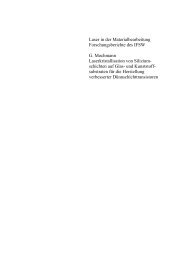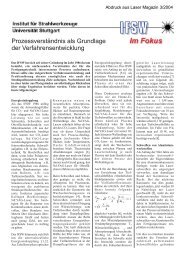Laser in der Materialbearbeitung Forschungsberichte des IFSW
Laser in der Materialbearbeitung Forschungsberichte des IFSW
Laser in der Materialbearbeitung Forschungsberichte des IFSW
Erfolgreiche ePaper selbst erstellen
Machen Sie aus Ihren PDF Publikationen ein blätterbares Flipbook mit unserer einzigartigen Google optimierten e-Paper Software.
14 Extended Abstract<br />
with high aspect ratios at improved weld<strong>in</strong>g quality for an enlarged process un<strong>der</strong>stand<strong>in</strong>g<br />
<strong>in</strong> or<strong>der</strong> to extend exist<strong>in</strong>g or to open up new application ranges.<br />
Generally, <strong>in</strong> case of low weld<strong>in</strong>g speed, the weld<strong>in</strong>g depth shows a clear dependence<br />
on the laser power. But at high enough weld<strong>in</strong>g speed (v � 6 m/m<strong>in</strong>) the curves of<br />
weld<strong>in</strong>g depth are well correlated by the beam parameter ratio (BPR), def<strong>in</strong>ed as laser<br />
power PL divided by the focus respectively spot diameter df. In this regime, the weld<strong>in</strong>g<br />
depth scales with the BPR which means that at PL = const the weld<strong>in</strong>g depth scales<br />
proportional to df -1 . In contrast to the above mentioned f<strong>in</strong>d<strong>in</strong>gs with CO2- and lamp<br />
pumped solid state lasers, weld<strong>in</strong>g experiments with the recent generation of the diode-pumped<br />
laser sources revealed characteristics not seen before: When the focus<br />
diameter on the workpiece was reduced, the achieved weld<strong>in</strong>g depth <strong>in</strong>creased accord<strong>in</strong>g<br />
to df -1 . This tendency, however, stops at low values of the focus diameter – <strong>in</strong> case<br />
of strong focusability below 200 μm. Even more, the weld<strong>in</strong>g depth becomes lower<br />
when the focus diameter is further decreased. Detailed experiments <strong>in</strong> a laser power<br />
range of up to 6 kW proved that both, the focus diameter and <strong>in</strong> particular the divergence<br />
angle of the focussed beam are decid<strong>in</strong>g for the result<strong>in</strong>g seam geometry. This<br />
behaviour is expla<strong>in</strong>ed with the distribution of l<strong>in</strong>es with constant power density.<br />
Therefore, with a further reduction of the beam parameter product (lower divergence<br />
angle at constant focus diameter) it is possible to obta<strong>in</strong> an <strong>in</strong>crease of the weld<strong>in</strong>g<br />
depth. An unexpected result of these experiments is further the fact, that the reachable<br />
cross sectional area which has been observed for both laser systems rema<strong>in</strong>s constant<br />
regardless of the aspect ratio of the weld seam. That means that <strong>in</strong> the <strong>in</strong>vestigated parameter<br />
range the process efficiency of keyhole weld<strong>in</strong>g is <strong>in</strong> fact <strong>in</strong>dependent of the<br />
focusability of the used laser source.<br />
Indeed, the knowledge of the essential <strong>in</strong>fluence of the divergence angle on the keyhole<br />
geometry and therewith on the achievable weld<strong>in</strong>g depth contributes to the profound<br />
process un<strong>der</strong>stand<strong>in</strong>g. However, not only the formation of the result<strong>in</strong>g weld<br />
seam but also the associated weld<strong>in</strong>g quality is of great <strong>in</strong>terest. Based on the previous<br />
results it is shown that the keyhole geometry itself can be directly manipulated by the<br />
divergence angle of the focussed laser beam due to stronger focusability. Even with<br />
small focus diameters a reduction of imperfections of the weld seam like process pores<br />
<strong>in</strong> alum<strong>in</strong>ium can be determ<strong>in</strong>ed. It is shown that a suitable process handl<strong>in</strong>g stabilises<br />
the keyhole and reduces the imperfections. Mechanisms which are <strong>in</strong>fluenc<strong>in</strong>g the<br />
weld<strong>in</strong>g process like that are for example a higher ablat<strong>in</strong>g rate or a more favourable<br />
shape of the keyhole. Because of that laser weld<strong>in</strong>g with strong focusability facilitates<br />
an improved weld<strong>in</strong>g quality. On the one hand, the reduction of the focus diameter










